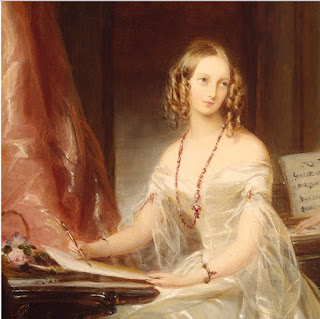 |
| Grand Duchesses Alexandra Nikolaievna ('Adini') and Alexandra Iosifovna ('Sanny') |
Grand Duchess Alexandra Nikolaievna was the youngest daughter of Emperor Nicholas I of Russia. She died at the tender age of 19 in childbirth. 'Adini' had been suffering from tuberculosis even before her marriage to Prince Frederick William of Hesse-Kassel, but it was soon after her wedding that her health deteriorated rapidly. Her illness, her difficult pregnancy, and her tragic death was a dark episode to the otherwise happy and idyllic family life of the Russian emperor.
Lively, talented, and mischievous, Adini was a favorite among her siblings, but she had a particular soft spot for her younger brother Konstantin who she called 'Kostya'. They bonded over shared love for music - she, a talented singer and he, a skillful player of musical instruments. Both were also artistically-inclined and voracious readers. When Adini died, Konstantin was on a sea voyage. He was then an officer of the Russian navy and when he received the news that his favorite sister died, he was profoundly affected. "...the sun's rays have faded forever in our family", he wrote in his journal. He often think about his sister, especially when he went on a campaign oversees, and he referred to her as his "guardian angel".
3 years after the death of Adini, he fell in love with and married a German princess, Alexandra of Saxe-Altenburg. Curiously, his chosen bride not only bore the name of his dead sister, but she also looked a lot like her. 'Sanny' was a highly attractive and lively girl. Furthermore, she was also a music and an art lover. These qualities of Sanny greatly reminded him of Adini. When Sanny came to Russia and was introduced to Konstantin's mother for the first time, the Empress could not help but notice the physical resemblance and burst into tears. The sight of her future daughter-in-law undoubtedly brought back the happy and sad memories about Adini.
 |
| Grand Duke Konstantin Nikolaievich ('Kostya') Portrait by Franz Kruger (State Hermitage Museum, Russia) |




























